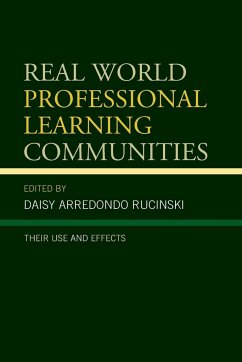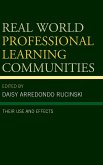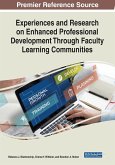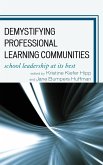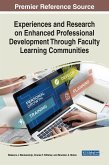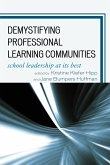- Broschiertes Buch
- Merkliste
- Auf die Merkliste
- Bewerten Bewerten
- Teilen
- Produkt teilen
- Produkterinnerung
- Produkterinnerung
In a professional learning community, teachers are organized into teams, committed to meeting on a regular basis to study their teaching strategies and the effects of those strategies on the students in their classrooms. Whatever the organizational structure, the teams have one goal, that is to improve teaching so that student learning is improved.
Andere Kunden interessierten sich auch für
![Real World Professional Learning Communities Real World Professional Learning Communities]() Daisy Arredondo RucinskiReal World Professional Learning Communities81,99 €
Daisy Arredondo RucinskiReal World Professional Learning Communities81,99 €![Professional Learning Communities Professional Learning Communities]() Barbara D. CulpProfessional Learning Communities61,99 €
Barbara D. CulpProfessional Learning Communities61,99 €![Experiences and Research on Enhanced Professional Development Through Faculty Learning Communities Experiences and Research on Enhanced Professional Development Through Faculty Learning Communities]() Experiences and Research on Enhanced Professional Development Through Faculty Learning Communities151,99 €
Experiences and Research on Enhanced Professional Development Through Faculty Learning Communities151,99 €![Demystifying Professional Learning Communities Demystifying Professional Learning Communities]() Demystifying Professional Learning Communities153,99 €
Demystifying Professional Learning Communities153,99 €![Experiences and Research on Enhanced Professional Development Through Faculty Learning Communities Experiences and Research on Enhanced Professional Development Through Faculty Learning Communities]() Experiences and Research on Enhanced Professional Development Through Faculty Learning Communities194,99 €
Experiences and Research on Enhanced Professional Development Through Faculty Learning Communities194,99 €![Demystifying Professional Learning Communities Demystifying Professional Learning Communities]() Demystifying Professional Learning Communities60,99 €
Demystifying Professional Learning Communities60,99 €![Faculty Learning Communities Faculty Learning Communities]() Faculty Learning Communities98,99 €
Faculty Learning Communities98,99 €-
-
-
In a professional learning community, teachers are organized into teams, committed to meeting on a regular basis to study their teaching strategies and the effects of those strategies on the students in their classrooms. Whatever the organizational structure, the teams have one goal, that is to improve teaching so that student learning is improved.
Produktdetails
- Produktdetails
- Verlag: Rowman & Littlefield Publishers
- Seitenzahl: 228
- Erscheinungstermin: 8. Dezember 2016
- Englisch
- Abmessung: 229mm x 152mm x 14mm
- Gewicht: 377g
- ISBN-13: 9781475822816
- ISBN-10: 1475822812
- Artikelnr.: 45467701
- Herstellerkennzeichnung
- Libri GmbH
- Europaallee 1
- 36244 Bad Hersfeld
- gpsr@libri.de
- Verlag: Rowman & Littlefield Publishers
- Seitenzahl: 228
- Erscheinungstermin: 8. Dezember 2016
- Englisch
- Abmessung: 229mm x 152mm x 14mm
- Gewicht: 377g
- ISBN-13: 9781475822816
- ISBN-10: 1475822812
- Artikelnr.: 45467701
- Herstellerkennzeichnung
- Libri GmbH
- Europaallee 1
- 36244 Bad Hersfeld
- gpsr@libri.de
Daisy Arredondo Rucinski
Foreword-Terri Croft Boman
Part I -Overview of book
Chapter 1: Introduction
Chapter 2: The Conceptual framework for Professional Learning Communities
as Reform Initiatives
Daisy Arredondo Rucinski (Example of use by Kyra L. Rhyne)
Part II - Use of PLCs in Elementary Schools
Chapter 3: Teacher reflection and teacher development in elementary schools
using Alabama's Instructional Partners Program (IPN)
Bradley A. Scott, Principal, Chaffee Elementary School, Huntsville, AL
Chapter 4: Elementary teacher reflection in professional learning
communities and teacher learning
Rachel Real Poovey - Supervisor of Elementary Education, Decatur, AL City
Schools
Chapter 5: Using PLC collaboration as a foundation for trust and teacher
efficacy in elementary schools
Datie I. Priest - Principal, West Decatur Elementary School, Decatur, AL
Part III - Use of PLCs in middle and high schools
Chapter 6: Relationships among professional learning communities, trust,
and student achievement in elementary and middle school mathematics.
Herbert A. Betts III - Madras Middle School, Assistant Principal, Coweta
School System, Newnan, GA
Chapter 7: School Culture, Professional Learning Community and Student
Achievement in Middle and High Schools
Amanda Hitson Cassity - District curriculum director, Northern Region,
Tuscaloosa County Schools, Tuscaloosa, AL
Chapter 8: Common Planning in High School Departments: A Structure for
Implementing Professional Learning Communities
Kyra L. Rhyne - District coordinator for virtual learning, Catoosa County
Schools, Ringold, GA
Part IV - School, District, and State contexts in using PLCs as a school
reform and accountability strategy:
Chapter 9: Using a professional learning community framework to support
response to intervention (RTI) in middle and high schools
Nicole Spiller - District Director of Student and Intervention Services,
Atlanta School System, Atlanta, GA
Chapter 10: Developing schools as professional learning communities: Does
district level leadership matter?
Terri Croft Boman - University - K-12 Professional Development Director
Chapter 11: Professional development in the states: How statutes and
regulations target teacher quality to improve student learning
Helen M. Hazi, Professor, West Virginia University and Daisy Arredondo
Rucinski - Professor, The University of Alabama
Part V - What the research says about the effects of using PLCs in schools
and student or teacher learning:
Chapter 12: Meta analyses of the research
Part 1: A meta-analytic review of dissertation research on Use of PLCs and
student achievement
Part 2: A Meta-analytic Review of the Published Research on Use of PLCs and
Student and Teacher Learning.
Susan McClendon Patrick, Secondary Curriculum Supervisor, Cullman County
Schools, Cullman, AL; Daisy Arredondo Rucinski, Professor; and Sara
Elizabeth Tomek, Associate Professor, UA.
Chapter 13: Conclusions, limitations, and implications for future research
Daisy Arredondo Rucinski
Index
Part I -Overview of book
Chapter 1: Introduction
Chapter 2: The Conceptual framework for Professional Learning Communities
as Reform Initiatives
Daisy Arredondo Rucinski (Example of use by Kyra L. Rhyne)
Part II - Use of PLCs in Elementary Schools
Chapter 3: Teacher reflection and teacher development in elementary schools
using Alabama's Instructional Partners Program (IPN)
Bradley A. Scott, Principal, Chaffee Elementary School, Huntsville, AL
Chapter 4: Elementary teacher reflection in professional learning
communities and teacher learning
Rachel Real Poovey - Supervisor of Elementary Education, Decatur, AL City
Schools
Chapter 5: Using PLC collaboration as a foundation for trust and teacher
efficacy in elementary schools
Datie I. Priest - Principal, West Decatur Elementary School, Decatur, AL
Part III - Use of PLCs in middle and high schools
Chapter 6: Relationships among professional learning communities, trust,
and student achievement in elementary and middle school mathematics.
Herbert A. Betts III - Madras Middle School, Assistant Principal, Coweta
School System, Newnan, GA
Chapter 7: School Culture, Professional Learning Community and Student
Achievement in Middle and High Schools
Amanda Hitson Cassity - District curriculum director, Northern Region,
Tuscaloosa County Schools, Tuscaloosa, AL
Chapter 8: Common Planning in High School Departments: A Structure for
Implementing Professional Learning Communities
Kyra L. Rhyne - District coordinator for virtual learning, Catoosa County
Schools, Ringold, GA
Part IV - School, District, and State contexts in using PLCs as a school
reform and accountability strategy:
Chapter 9: Using a professional learning community framework to support
response to intervention (RTI) in middle and high schools
Nicole Spiller - District Director of Student and Intervention Services,
Atlanta School System, Atlanta, GA
Chapter 10: Developing schools as professional learning communities: Does
district level leadership matter?
Terri Croft Boman - University - K-12 Professional Development Director
Chapter 11: Professional development in the states: How statutes and
regulations target teacher quality to improve student learning
Helen M. Hazi, Professor, West Virginia University and Daisy Arredondo
Rucinski - Professor, The University of Alabama
Part V - What the research says about the effects of using PLCs in schools
and student or teacher learning:
Chapter 12: Meta analyses of the research
Part 1: A meta-analytic review of dissertation research on Use of PLCs and
student achievement
Part 2: A Meta-analytic Review of the Published Research on Use of PLCs and
Student and Teacher Learning.
Susan McClendon Patrick, Secondary Curriculum Supervisor, Cullman County
Schools, Cullman, AL; Daisy Arredondo Rucinski, Professor; and Sara
Elizabeth Tomek, Associate Professor, UA.
Chapter 13: Conclusions, limitations, and implications for future research
Daisy Arredondo Rucinski
Index
Foreword-Terri Croft Boman
Part I -Overview of book
Chapter 1: Introduction
Chapter 2: The Conceptual framework for Professional Learning Communities
as Reform Initiatives
Daisy Arredondo Rucinski (Example of use by Kyra L. Rhyne)
Part II - Use of PLCs in Elementary Schools
Chapter 3: Teacher reflection and teacher development in elementary schools
using Alabama's Instructional Partners Program (IPN)
Bradley A. Scott, Principal, Chaffee Elementary School, Huntsville, AL
Chapter 4: Elementary teacher reflection in professional learning
communities and teacher learning
Rachel Real Poovey - Supervisor of Elementary Education, Decatur, AL City
Schools
Chapter 5: Using PLC collaboration as a foundation for trust and teacher
efficacy in elementary schools
Datie I. Priest - Principal, West Decatur Elementary School, Decatur, AL
Part III - Use of PLCs in middle and high schools
Chapter 6: Relationships among professional learning communities, trust,
and student achievement in elementary and middle school mathematics.
Herbert A. Betts III - Madras Middle School, Assistant Principal, Coweta
School System, Newnan, GA
Chapter 7: School Culture, Professional Learning Community and Student
Achievement in Middle and High Schools
Amanda Hitson Cassity - District curriculum director, Northern Region,
Tuscaloosa County Schools, Tuscaloosa, AL
Chapter 8: Common Planning in High School Departments: A Structure for
Implementing Professional Learning Communities
Kyra L. Rhyne - District coordinator for virtual learning, Catoosa County
Schools, Ringold, GA
Part IV - School, District, and State contexts in using PLCs as a school
reform and accountability strategy:
Chapter 9: Using a professional learning community framework to support
response to intervention (RTI) in middle and high schools
Nicole Spiller - District Director of Student and Intervention Services,
Atlanta School System, Atlanta, GA
Chapter 10: Developing schools as professional learning communities: Does
district level leadership matter?
Terri Croft Boman - University - K-12 Professional Development Director
Chapter 11: Professional development in the states: How statutes and
regulations target teacher quality to improve student learning
Helen M. Hazi, Professor, West Virginia University and Daisy Arredondo
Rucinski - Professor, The University of Alabama
Part V - What the research says about the effects of using PLCs in schools
and student or teacher learning:
Chapter 12: Meta analyses of the research
Part 1: A meta-analytic review of dissertation research on Use of PLCs and
student achievement
Part 2: A Meta-analytic Review of the Published Research on Use of PLCs and
Student and Teacher Learning.
Susan McClendon Patrick, Secondary Curriculum Supervisor, Cullman County
Schools, Cullman, AL; Daisy Arredondo Rucinski, Professor; and Sara
Elizabeth Tomek, Associate Professor, UA.
Chapter 13: Conclusions, limitations, and implications for future research
Daisy Arredondo Rucinski
Index
Part I -Overview of book
Chapter 1: Introduction
Chapter 2: The Conceptual framework for Professional Learning Communities
as Reform Initiatives
Daisy Arredondo Rucinski (Example of use by Kyra L. Rhyne)
Part II - Use of PLCs in Elementary Schools
Chapter 3: Teacher reflection and teacher development in elementary schools
using Alabama's Instructional Partners Program (IPN)
Bradley A. Scott, Principal, Chaffee Elementary School, Huntsville, AL
Chapter 4: Elementary teacher reflection in professional learning
communities and teacher learning
Rachel Real Poovey - Supervisor of Elementary Education, Decatur, AL City
Schools
Chapter 5: Using PLC collaboration as a foundation for trust and teacher
efficacy in elementary schools
Datie I. Priest - Principal, West Decatur Elementary School, Decatur, AL
Part III - Use of PLCs in middle and high schools
Chapter 6: Relationships among professional learning communities, trust,
and student achievement in elementary and middle school mathematics.
Herbert A. Betts III - Madras Middle School, Assistant Principal, Coweta
School System, Newnan, GA
Chapter 7: School Culture, Professional Learning Community and Student
Achievement in Middle and High Schools
Amanda Hitson Cassity - District curriculum director, Northern Region,
Tuscaloosa County Schools, Tuscaloosa, AL
Chapter 8: Common Planning in High School Departments: A Structure for
Implementing Professional Learning Communities
Kyra L. Rhyne - District coordinator for virtual learning, Catoosa County
Schools, Ringold, GA
Part IV - School, District, and State contexts in using PLCs as a school
reform and accountability strategy:
Chapter 9: Using a professional learning community framework to support
response to intervention (RTI) in middle and high schools
Nicole Spiller - District Director of Student and Intervention Services,
Atlanta School System, Atlanta, GA
Chapter 10: Developing schools as professional learning communities: Does
district level leadership matter?
Terri Croft Boman - University - K-12 Professional Development Director
Chapter 11: Professional development in the states: How statutes and
regulations target teacher quality to improve student learning
Helen M. Hazi, Professor, West Virginia University and Daisy Arredondo
Rucinski - Professor, The University of Alabama
Part V - What the research says about the effects of using PLCs in schools
and student or teacher learning:
Chapter 12: Meta analyses of the research
Part 1: A meta-analytic review of dissertation research on Use of PLCs and
student achievement
Part 2: A Meta-analytic Review of the Published Research on Use of PLCs and
Student and Teacher Learning.
Susan McClendon Patrick, Secondary Curriculum Supervisor, Cullman County
Schools, Cullman, AL; Daisy Arredondo Rucinski, Professor; and Sara
Elizabeth Tomek, Associate Professor, UA.
Chapter 13: Conclusions, limitations, and implications for future research
Daisy Arredondo Rucinski
Index

